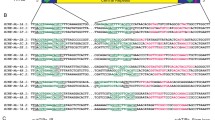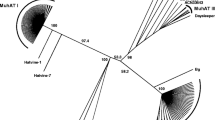Abstract
The small genomes of fungi are expected to have little repetitive content other than rDNA genes. Moreover, among asexual or highly selfing lineages, the diversity of repetitive elements is also expected to be very low. However, in the automictic fungus Microbotryum violaceum, a very large proportion of random DNA fragments from the autosomes and the fungal sex chromosomes are repetitive in nature, either as retrotransposon or helicase sequences. Among the retrotransposon sequences, examples were found from each major kind of elements, including copia, gypsy, and non-LTR sequences. The most numerous were copia-like elements, which are believed to be rare in fungi, particularly among basidiomycetes. The many helicase sequences appear to belong to the recently discovered Helitron type of transposable elements. Also, sequences that could not be identified as a known type of gene were also very repetitive within the database of random fragments from M. violaceum. The differentiated pair of fungal sex chromosomes and suppression of recombination may be the major forces determining the highly repetitive content in the small genome of M. violaceum.
Similar content being viewed by others
References
Antonovics, J., J.Y. Abrams, 2004. Intra-tetrad mating and the evolution of linkage relationships. Evolution
J. Antonovics M. Hood J. Partain (2002) ArticleTitleThe ecology and genetics of a host shift: Microbotryum as a model system American Naturalist 160 S40–S53 Occurrence Handle10.1086/342143
U. Arkhipova M. Meselson (2000) ArticleTitleTransposable elements in sexual and ancient asexual taxa Proceeding of the National Academy of Science USA 97 14473–14477 Occurrence Handle10.1073/pnas.97.26.14473 Occurrence Handle1:CAS:528:DC%2BD3MXitVCqsA%3D%3D
G. Benson (1999) ArticleTitleTandem repeats finder: a program to analyze DNA sequences Nucleic Acids Res 27 573–580 Occurrence Handle10.1093/nar/27.2.573 Occurrence Handle1:CAS:528:DyaK1MXhtVKmtrg%3D Occurrence Handle9862982
J. Brosius (1999) ArticleTitleGenomes were forged by massive bombardments with retroelements and retrosequences Genetica 107 209–238 Occurrence Handle10.1023/A:1004018519722 Occurrence Handle1:CAS:528:DC%2BD3cXmtVChsrg%3D Occurrence Handle10952214
J.M. Casacuberta N. Santiago (2003) ArticleTitlePlant LTR-retrotransposons and MITEs: control of trasposition and impact on the evolution of plant genes and genomes Gene 311 1–11 Occurrence Handle10.1016/S0378-1119(03)00557-2 Occurrence Handle1:CAS:528:DC%2BD3sXltFGjsr4%3D Occurrence Handle12853133
B. Charlesworth C.H. Langley (1989) ArticleTitleThe population genetics of Drosophila transposable elements Ann. Rev. Genet. 23 251–287 Occurrence Handle10.1146/annurev.ge.23.120189.001343 Occurrence Handle1:STN:280:By%2BC2cnitFE%3D Occurrence Handle2559652
M.J. Daboussi (1997) ArticleTitleFungal transposable elements and genome evolution Genetica 100 253–260 Occurrence Handle10.1023/A:1018354200997 Occurrence Handle1:CAS:528:DyaK1cXkslWksg%3D%3D Occurrence Handle9440278
J. Díez T. Béguiristain F. Le Tacon J.M. Casacuterta D. Tagu (2003) ArticleTitleIdentification of Ty1-copia retrotransposons in three ectomycorrhizal basidiomycetes: evolutionary relationships and use as molecular markers Curr. Genetics 43 34–44
W. Feller (1957) An Introduction to Probability Theory and Its Applications EditionNumber2 John Wiley and Sons Inc. New York
A.B. Freeman K.K. Duong T.L. Shi C.F. Hughes M.H. Perlin (2002) ArticleTitleIsolates of Microbotryum violaceum from North American host species are phylogenetically distinct from their European host-derived counterparts Mol. Phyl. Evol. 23 158–170 Occurrence Handle10.1016/S1055-7903(02)00003-9 Occurrence Handle1:CAS:528:DC%2BD38XksFOnsLg%3D
E.D. Garber M. Ruddat (1994) ArticleTitleGenetics of Ustilago violacea XXXII. Genetic evidence for transposable elements Theor. Appl. Genetics 89 838–846 Occurrence Handle1:CAS:528:DyaK2MXkt1emtr4%3D
E.D. Garber M. Ruddat (1998) ArticleTitleGenetics of Ustilago violacea XXXIV. Genetic evidence for a transposable element functioning during mitosis and two transposable elements functioning during meiosis. Int. J. Plant Sci. 159 1018–1022
E.D. Garber M. Ruddat (2000) ArticleTitleGenetics of Ustilago violacea XXXV. Transposition in haploid and diploid sporidia and germinating teliospores. Int. J. Plant Sci. 161 227–231
E.D. Garber M. Ruddat (2002) ArticleTitleTransmission genetics of Microbotryum violaceum (Ustilago violacea): A case history Adv. Appl. Microbiol. 51 107–127 Occurrence Handle1:CAS:528:DC%2BD38XotFOgu7s%3D Occurrence Handle12236055
T.J.D. Goodwin T.M. Poulter (2001) ArticleTitleThe diversity of retrotransposons in the yeast Cryptococcus neoformans Yeast 18 865–880 Occurrence Handle10.1002/yea.733 Occurrence Handle1:CAS:528:DC%2BD3MXlt1CqtLo%3D Occurrence Handle11427969
R. Gorelick (2003) ArticleTitleTransposable elements suppress recombination in all meiotic eukaryotes, including automictic ancient asexuals: a reply to Schön and Martens J. Nat History 37 903–909 Occurrence Handle10.1080/0022293021000007705
M.E. Hood (2002) ArticleTitleDimorphic mating-type chromosomes in the fungus Microbotryum violaceum Genetics 160 457–461 Occurrence Handle1:CAS:528:DC%2BD38XitlWkurc%3D Occurrence Handle11861552
M.E. Hood J. Antonovics (2004) ArticleTitleMating within the meiotic tetrad and the maintenance of genomic heterozygosity Genetics 166 1751–1759 Occurrence Handle10.1534/genetics.166.4.1751 Occurrence Handle1:CAS:528:DC%2BD2cXkvF2hu78%3D Occurrence Handle15126395
M.E. Hood J. Antonovics H. Heishman (2003) ArticleTitleKaryotypic similarity identifies multiple host-shifts of a pathogenic fungus in natural populations Infect. Genetics Evol. 2 167–172 Occurrence Handle10.1016/S1567-1348(02)00154-5
Hood M.E., Antonovics J., Koskella B. (2004). Shared forces of sex chromosome evolution in haploid-mating and diploid-mating organisms. Genetics
G.D.D. Hurst J.H. Werren (2001) ArticleTitleThe role of selfish genetic elements in eukaryotic evolution Nat. Rev. Genetics 2 597–606 Occurrence Handle10.1038/35084545 Occurrence Handle1:CAS:528:DC%2BD3MXlvVaqt7Y%3D
V.V. Kapitonov J. Jurka (2001) ArticleTitleRolling-circle transposons in eukaryotes Proc. Nat. Acad. Sci. USA 98 8714–8719 Occurrence Handle10.1073/pnas.151269298 Occurrence Handle1:CAS:528:DC%2BD3MXls1WitLo%3D Occurrence Handle11447285
F. Kempken U. Kück (1998) ArticleTitleTransposons in filamentous fungi – facts and perspectives BioEssarys 20 652–659 Occurrence Handle10.1002/(SICI)1521-1878(199808)20:8<652::AID-BIES8>3.0.CO;2-K Occurrence Handle1:STN:280:DyaK1M%2Fjs1Sjsg%3D%3D
M.G. Kidwell (2002) ArticleTitleTransposable elements and the evolution of genome size in eukaryotes Genetica 115 49–63 Occurrence Handle10.1023/A:1016072014259 Occurrence Handle1:CAS:528:DC%2BD38XkvVaisLY%3D Occurrence Handle12188048
M.G. Kidwell D.R. Lisch (2001) ArticleTitlePerspective: Transposable elements, parasitic DNA, and genome evolution Evolution 55 1–24 Occurrence Handle1:CAS:528:DC%2BD3MXhvFKksLw%3D Occurrence Handle11263730
S. Kumar K. Tamura I.B. Jakobsen M. Nei (2001) ArticleTitleMEGA2: molecular evolutionary genetics analysis software Bioinformatics 17 1244–1245 Occurrence Handle10.1093/bioinformatics/17.12.1244 Occurrence Handle1:CAS:528:DC%2BD38XmtVCktQ%3D%3D Occurrence Handle11751241
W.-E. Lönnig H. Saedler (2002) ArticleTitleChromosome rearrangements and transposable elements Ann. Rev. Genetics 36 389–410 Occurrence Handle10.1146/annurev.genet.36.040202.092802
etal. Mannhaupt G. (2003) ArticleTitleWhat’s in the genome of a filamentous fungus? Analysis of the Neurospora genome sequence Nucl. Acids Res. 31 1944–1954 Occurrence Handle10.1093/nar/gkg293 Occurrence Handle12655011
M.T. Morgan (2001) ArticleTitleTransposable element number in mixed mating populations Genetical Res. 77 261–275 Occurrence Handle10.1017/S0016672301005067 Occurrence Handle1:CAS:528:DC%2BD3MXmtVKitLc%3D
P. Nouvel (1994) ArticleTitleThe mammalian genome shaping activity of reverse-transcriptase Genetica 93 191–201 Occurrence Handle10.1007/BF01435251 Occurrence Handle1:CAS:528:DyaK2MXislOmsbc%3D Occurrence Handle7529206
S.V. Nuzhdin D.A. Petrov (2003) ArticleTitleTransposable elements in clonal lineages: lethal hangover from sex Biol. J. Linnean Soc. 79 33–41 Occurrence Handle10.1046/j.1095-8312.2003.00188.x
M.H. Perlin C. Hughes J. Welch S. Akkaraju D. Steinecker A. Kumar B. Smith S. Garr S. Brown T. Andom (1997) ArticleTitleMolecular approaches to differentiate subpopulations or formae speciales of the fungal phytopathogen Microbotryum violaceum Int. J. Plant Sci. 158 568–574 Occurrence Handle10.1086/297469 Occurrence Handle1:CAS:528:DyaK2sXnsVygsrg%3D
T.V. Perneger (1998) ArticleTitleWhat’s wrong with Bonferroni adjustments British Med. J. 316 1236–1238 Occurrence Handle1:STN:280:DyaK1c3itFSmtg%3D%3D
R.T.M. Poulter T.J.D. Goodwin M.I. Bulter (2003) ArticleTitleVertebrate helentrons and other novel Helitrons Gene 313 201–212 Occurrence Handle10.1016/S0378-1119(03)00679-6 Occurrence Handle1:CAS:528:DC%2BD3sXmvVartLg%3D Occurrence Handle12957391
J.A. Shapiro (2002) ArticleTitleRepetitive DNA, genome system architecture and genome reorganization Res. Microbiol. 153 447–453 Occurrence Handle10.1016/S0923-2508(02)01344-X Occurrence Handle1:CAS:528:DC%2BD38XmtlGqs7s%3D Occurrence Handle12405352
A.V. Shnyreva (2003) ArticleTitleTransposable elements are the factors involved in various rearrangements and modifications of the fungal genomes Russian J. Genetics 39 505–518 Occurrence Handle10.1023/A:1023727515950 Occurrence Handle1:CAS:528:DC%2BD3sXjslGrsbk%3D
R.R. Sokal F.J. Rohlf (1995) Biometry: The Principles and Practice of Statistics in Biological Research W.H. Freeman and Company New York
J. Wöstemeyer A. Kreibich (2002) ArticleTitleRepetitive DNA elements in fungi (Mycota): impact on genomic architecture and evolution Curr. Genetics 41 189–198 Occurrence Handle10.1007/s00294-002-0306-y
Y. Xiong T.H. Eickbush (1988) ArticleTitleSimilarity of reverse transcriptase-like sequences of viruses, transposable elements, and mitochondrial introns Mol. Biol. Evol. 5 675–690 Occurrence Handle1:STN:280:BiaC38nptlI%3D Occurrence Handle2464735
Author information
Authors and Affiliations
Corresponding author
Rights and permissions
About this article
Cite this article
Hood, M.E. Repetitive DNA in the automictic fungus Microbotryum violaceum. Genetica 124, 1–10 (2005). https://doi.org/10.1007/s10709-004-6615-y
Received:
Accepted:
Issue Date:
DOI: https://doi.org/10.1007/s10709-004-6615-y




